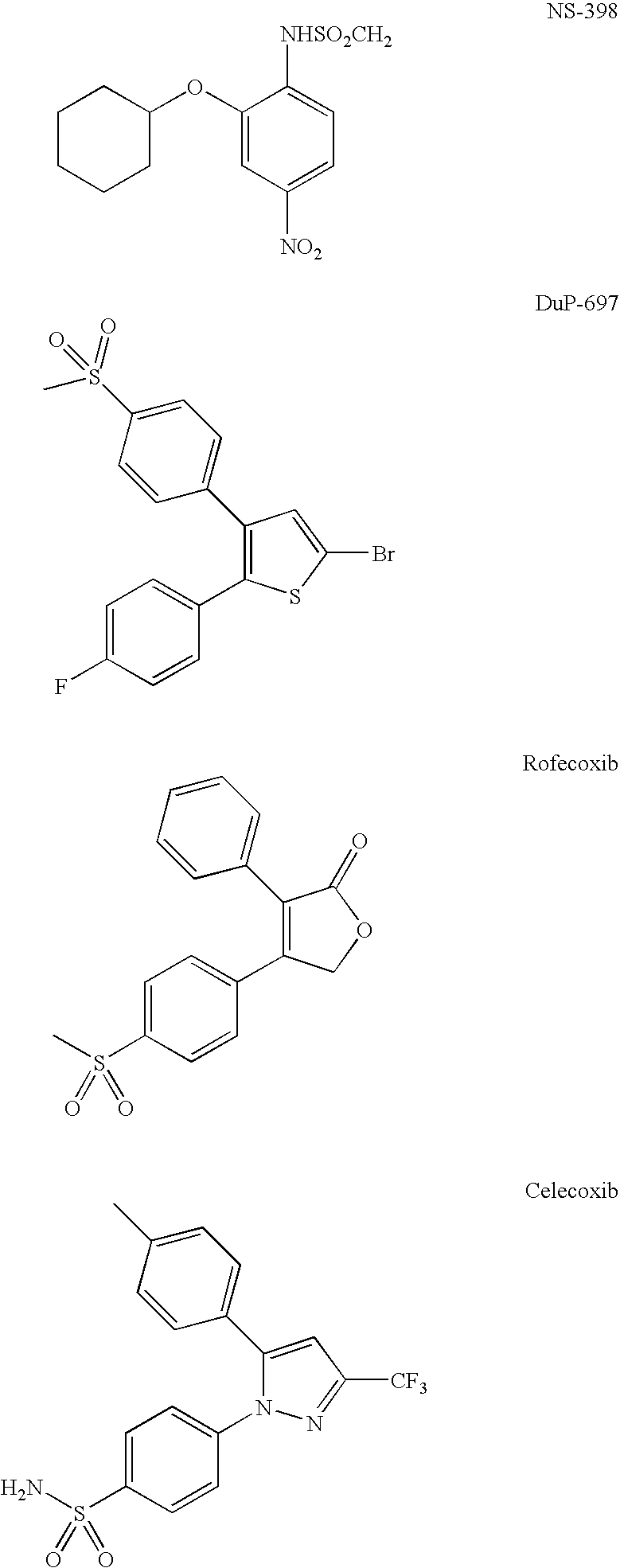Optical imaging of colorectal cancer
- Summary
- Abstract
- Description
- Claims
- Application Information
AI Technical Summary
Benefits of technology
Problems solved by technology
Method used
Image
Examples
example 1
Contrast Agent for Mapping of COX-2 Activity. Synthesis of COX-2 Ligand Coupled to Fluorescein
[0107] Step 1
[0108] 2-Hydroxy-1-(4-methanesulfonylphenyl)ethanone is prepared from 2-bromo-1-(4-methanosulfonylphenyl)ethanone according to C. Puig et al in J. Med. Chem 2000,43, 214-223.
[0109] Step 2
[0110] A solution of 2-hydroxy-1-(4-methanosulfonylphenyl)ethanone (1.50 g, 7 mmol) and fluorescein isocyanate isomer 1 (2.72 g, 7 mmol) is heated in DMF at 120° C. for 5 hours.
[0111] The mixture is cooled, DMF evaporated off and acetic acid (25 ml) is added. The mixture is refluxed for 10 hours. The acetic acid is evaporated and the resulting mixture is purified on silica using chloroform / methanol as eluent.
example 2
Contrast Agent for Mapping of Matrix Metalloproteinase (MMP). Synthesis of fluorescein-Cys-Gly-Pro-Leu-Gly-Leu-Leu-Ala-Arg-OH Linker Conjugate
[0112] Step 1
[0113] The peptide component was synthesised on an ABI 433A automatic peptide synthesiser starting with Fmoc—Arg(Pmc)—wang resin on a 0.1 mmol scale using 1 mmol amino acid cartridges. The amino acids were pre-activated using HBTU before coupling. An aliquot of the peptide resin was then transferred to a clean round bottom flask an N-methyl morpholine (1 mmol) in DMF (5 ml) added followed by chloroacetyl chloride (1 mmol). The mixture was gently shaken until Kaiser test negative. The resin was extensively washed with DMF.
[0114] Step 2
[0115] 5(6)—carboxyfluorescein (188 mg, 0.5 mmol) and dicyclohexylcarbodiimide (113 mg, 0.55 mmol) are dissolved in DMF (20 ml). The mixture is stirred for 2 hours and cooled to 0° C. A solution of hexamethylenediamide (116 mg, 1 mmol) and DMAP (30 mg) in DMF is added and the mixture is stirred at...
example 3
Contrast Agent for Binding to Benzodiazepine Receptor
[0119] Step 1
[0120] Nitrazepam is reduced to the corresponding 7-aminonitrazepam using standard condition zink in aqueous hydrochloric acid, catalytic hydrogenation or other reduction agents.
[0121] Step 2
[0122] 5(6) Carboxyfluorescein (1 mmol) and dicyclohexylcarbodiimide (1 mmol) are dissolved in DMF (30 ml). The mixture is stirred for 2 hours at ambient temperature. A solution of 7-aminonitrazepam (1 mmol) and DMAP (20 mg) in DMF (10 ml) is added and the mixture is evaporated and the conjugate between 7-aminonitrazepam and 5(6) carboxyfluorescein is isolated by chromatography (silica, chloroform / methanol).
PUM
| Property | Measurement | Unit |
|---|---|---|
| Mass | aaaaa | aaaaa |
| Solubility (mass) | aaaaa | aaaaa |
| Molecular weight | aaaaa | aaaaa |
Abstract
Description
Claims
Application Information
 Login to View More
Login to View More - R&D
- Intellectual Property
- Life Sciences
- Materials
- Tech Scout
- Unparalleled Data Quality
- Higher Quality Content
- 60% Fewer Hallucinations
Browse by: Latest US Patents, China's latest patents, Technical Efficacy Thesaurus, Application Domain, Technology Topic, Popular Technical Reports.
© 2025 PatSnap. All rights reserved.Legal|Privacy policy|Modern Slavery Act Transparency Statement|Sitemap|About US| Contact US: help@patsnap.com



